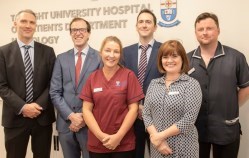 (August 23rd 2019) Tallaght University Hospital today completed the move of some Out Patient Clinics to the Simms Building in Tallaght. Following the move last October of the Endocrinology, Diabetes and Podiatry outpatient services the Hospital’s Neurology Clinics have moved to the Simms Building. The Hospital also officially opened the Robert Graves Exhibition which is on permanent display on level 2 of the building in the Robert Graves Institute of Endocrinology.
(August 23rd 2019) Tallaght University Hospital today completed the move of some Out Patient Clinics to the Simms Building in Tallaght. Following the move last October of the Endocrinology, Diabetes and Podiatry outpatient services the Hospital’s Neurology Clinics have moved to the Simms Building. The Hospital also officially opened the Robert Graves Exhibition which is on permanent display on level 2 of the building in the Robert Graves Institute of Endocrinology.
Over 20,000 Out Patient appointments now take place in over 2,300 clinics a year in the 15,000 sq. feet of purpose built modern outpatient facilities which are located within 500 metres of the Hospital’s main entrance. The move is part of initiatives to relocate suitable services from the Hospital setting and locate them in the community.
Commenting on the completion of the move, Lucy Nugent, Chief Executive of Tallaght University Hospital commented “I would like to acknowledge the enormous effort by a large team of staff in the Hospital and support from the HSE in moving these clinics out of the Hospital and into the community. Feedback from staff working in this modern facility and from our patients is overwhelmingly positive and brings us a step forward in our vision for healthcare into the community and being a Hospital without walls.”
Commenting on the opening of the permanent exhibition Mairéad Shields, Chairman of the Meath Foundation commented “A large number of patients attend the Robert Graves Institute of Endocrinology in the Simms Building, I am delighted to see the permanent exhibition open which displays the history of diabetes and the changing treatments that have been developed over the years providing something for patients to read whilst waiting for their appointments. Moving into this new building enables the clinicians to continue research into this area of medicine but it is important to recognise the long tradition of teaching from the past.”
About Tallaght University Hospital
TUH is one of Ireland’s largest acute teaching hospitals, adult, psychiatric and age-related healthcare on one site. The Hospital has 495 adult beds with 3,000 people on staff. The Hospital is a provider of local, regional and national specialties. It is also a national urology centre, the second largest provider of dialysis services in the country and a regional orthopaedic trauma centre. The Hospital also has 67 paediatric beds under the governance of Children’s Health Ireland and 52 mental health beds under HSE governance.
TUH is one of the two main teaching hospitals of Trinity College Dublin - specialising in the training and professional development of staff in areas such as nursing, health and social care professionals, emergency medicine and surgery, amongst many others. TUH is part of the Dublin Midlands Hospital Group which serves a population of over 1.2 million across seven counties.
A new paediatric outpatient and urgent care centre is to be built at TUH as part of the Children’s Health Ireland project as a key element of an integrated clinical network for paediatric services nationally. The Hospital’s Emergency Departments catered for 51,084 Adult Attendance and 32,424 Paediatric Attendance in 2018. A further 267,623 patients were treated through the Hospital’s Adult and Paediatric outpatient clinics in 2018. The Hospital’s operations are supported by 200 general practitioners in surrounding communities and aligned with Community Health Organisation 7.
About Robert James Graves (b. 1796, d.1853, Dublin). He received his degree from the University of Dublin in 1818. He was appointed Physician at the Meath Hospital in 1821 which was the golden period of Irish medicine. He was a leader of the Irish, or Dublin, school of diagnosis, which emphasised the clinical observation of patients and which significantly advanced the fields of physical diagnosis and internal medicine.
During his time at the Meath he introduced reforms in medical training. In addition to teaching traditional textbook medicine, Graves assigned to advanced students the responsibility for diagnosis and treatment of ward patients, under the supervision of the faculty. Like other progressive professors of his times, he gave his lectures in English rather than in Latin. Graves was named regius professor of the Institute of Medicine in Trinity College in recognition of his achievements in education. A founder of the Dublin Journal of Medical Science, he served as one of the journal’s editors until his death.
Graves was one of the first physicians to fully describe exophthalmic goitre, now called Graves disease. His Clinical Lectures on the Practice of Medicine, published in 1848, are responsible for establishing his enduring reputation. Among the innovations introduced in the lectures were the timing of the pulse by watch and the practice of giving food and liquids to patients with fevers instead of withholding nourishment from them. Graves facetiously suggested that his epitaph should read, “He fed fevers.”